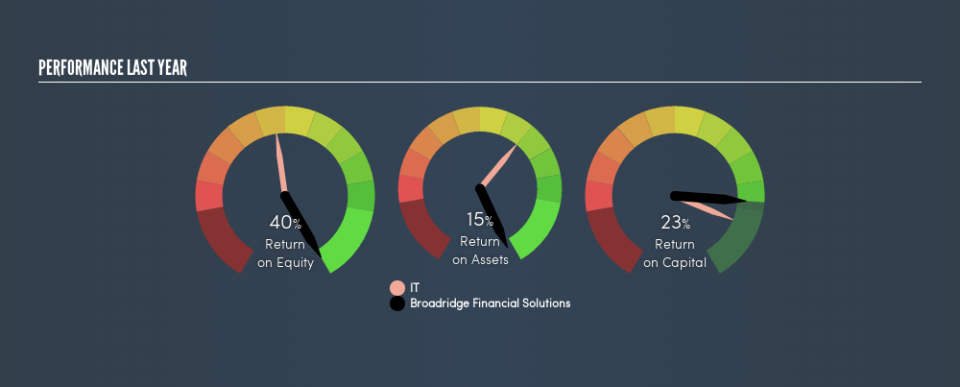Why Broadridge Financial Solutions, Inc.’s (NYSE:BR) Return On Capital Employed Is Impressive

Want to participate in a short research study? Help shape the future of investing tools and you could win a $250 gift card!
Today we are going to look at Broadridge Financial Solutions, Inc. (NYSE:BR) to see whether it might be an attractive investment prospect. Specifically, we're going to calculate its Return On Capital Employed (ROCE), in the hopes of getting some insight into the business.
First, we'll go over how we calculate ROCE. Second, we'll look at its ROCE compared to similar companies. Finally, we'll look at how its current liabilities affect its ROCE.
Return On Capital Employed (ROCE): What is it?
ROCE measures the amount of pre-tax profits a company can generate from the capital employed in its business. Generally speaking a higher ROCE is better. Ultimately, it is a useful but imperfect metric. Renowned investment researcher Michael Mauboussin has suggested that a high ROCE can indicate that 'one dollar invested in the company generates value of more than one dollar'.
So, How Do We Calculate ROCE?
Analysts use this formula to calculate return on capital employed:
Return on Capital Employed = Earnings Before Interest and Tax (EBIT) ÷ (Total Assets - Current Liabilities)
Or for Broadridge Financial Solutions:
0.23 = US$675m ÷ (US$3.6b - US$705m) (Based on the trailing twelve months to March 2019.)
So, Broadridge Financial Solutions has an ROCE of 23%.
Check out our latest analysis for Broadridge Financial Solutions
Does Broadridge Financial Solutions Have A Good ROCE?
When making comparisons between similar businesses, investors may find ROCE useful. Broadridge Financial Solutions's ROCE appears to be substantially greater than the 9.7% average in the IT industry. I think that's good to see, since it implies the company is better than other companies at making the most of its capital. Setting aside the comparison to its industry for a moment, Broadridge Financial Solutions's ROCE in absolute terms currently looks quite high.
You can see in the image below how Broadridge Financial Solutions's ROCE compares to its industry. Click to see more on past growth.
When considering ROCE, bear in mind that it reflects the past and does not necessarily predict the future. ROCE can be misleading for companies in cyclical industries, with returns looking impressive during the boom times, but very weak during the busts. This is because ROCE only looks at one year, instead of considering returns across a whole cycle. Future performance is what matters, and you can see analyst predictions in our free report on analyst forecasts for the company.
How Broadridge Financial Solutions's Current Liabilities Impact Its ROCE
Current liabilities are short term bills and invoices that need to be paid in 12 months or less. The ROCE equation subtracts current liabilities from capital employed, so a company with a lot of current liabilities appears to have less capital employed, and a higher ROCE than otherwise. To check the impact of this, we calculate if a company has high current liabilities relative to its total assets.
Broadridge Financial Solutions has total liabilities of US$705m and total assets of US$3.6b. As a result, its current liabilities are equal to approximately 20% of its total assets. The fairly low level of current liabilities won't have much impact on the already great ROCE.
Our Take On Broadridge Financial Solutions's ROCE
Low current liabilities and high ROCE is a good combination, making Broadridge Financial Solutions look quite interesting. There might be better investments than Broadridge Financial Solutions out there, but you will have to work hard to find them . These promising businesses with rapidly growing earnings might be right up your alley.
If you like to buy stocks alongside management, then you might just love this free list of companies. (Hint: insiders have been buying them).
We aim to bring you long-term focused research analysis driven by fundamental data. Note that our analysis may not factor in the latest price-sensitive company announcements or qualitative material.
If you spot an error that warrants correction, please contact the editor at editorial-team@simplywallst.com. This article by Simply Wall St is general in nature. It does not constitute a recommendation to buy or sell any stock, and does not take account of your objectives, or your financial situation. Simply Wall St has no position in the stocks mentioned. Thank you for reading.

